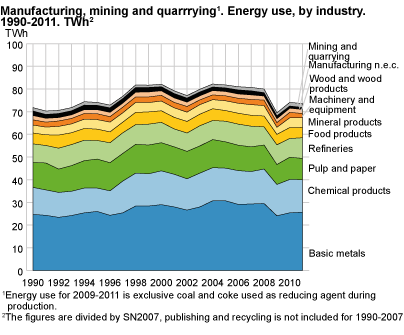Content
Published:
This is an archived release.
Minor changes in energy use
Total energy use in manufacturing, mining and quarrying amounted to 80 384 GWh in 2011. This is the same level as in 2010, when the energy use amounted to 80 476 GWh. Total energy costs amounted to NOK 20 335 million; an increase of 5.4 per cent from 2010.
Norwegian manufacturing, mining and quarrying is a large and heterogeneous group of industries. Energy use in these industries is affected to varying degrees by factors such as changes in product prices and demand, and changes in energy prices and other costs. Statistics Norway’s Index of Production shows a slight increase in production from 2010 to 2011. Higher energy prices and warmer weather in 2011 than in 2010 could explain the decrease in energy use.
End of government controlled electricity contracts
Electricity accounted for 54 per cent of total energy consumption in 2011. The use of purchased electricity amounted to 43.2 TWh in 2011; a small decrease of 1.5 per cent compared to 2010. Power-intensive industries account for over 80 per cent of energy consumption in manufacturing, mining and quarrying. Electricity consumption in pulp and paper industries fell by 11 per cent compared to 2010. Basic metals had on the other hand a 2.5 per cent increase in electricity consumption.
The average electricity price for manufacturing, mining and quarrying increased by 4 per cent, from 32.6 øre/ kWh in 2010 (excl. taxes, incl. grid rent) to 33.9 øre/ kWh in 2011. The electricity price in basic metals production increased by 8.7 per cent from 22.9 øre/ kWh to 24.9 øre/ kWh. The end of government controlled electricity contracts may explain this. The power intensive industries now have to buy electricity through competitive electricity contracts.
Decreased consumption of heating oils
All industries, except mining and quarrying, had a decrease in the consumption of petroleum products for stationary purposes. Overall, the decrease was 11.6 per cent from 2010 to 2011. The consumption of heating oils depends on the temperature. The major change from 2010 can be linked to the warm weather in 2011 and the particularly low temperatures in 2010. The price of petroleum products increased on average by 16.2 per cent from 2010 to 2011. The higher prices could also explain the decline in consumption.
Other energy
Self-produced energy accounted for 19.5 per cent of the total energy consumption in 2011. This is an increase by 384 GWh, or 2.5 per cent compared to 2010. It is primarily self-produced bio energy from fire wood and waste wood that is behind the increase. Purchased fire wood and waste wood increased by 7.4 per cent from 2010 to 2011. The use of purchased steam also showed a clear increase.
Coal and coke as a reducing agentCoal, coke etc. used as a reducing agent during production is regarded as fuel in the energy balance and is therefore included in the statistics from 2009. This is, for example, used in the production of basic metals. The use of coal and coke as a reducing agent during production was 6.8 TWh in 2011. |
Tables:
- Table 1 Energy consumption in establishments in maufacturing, mining and quarrying. Overview. Preliminary figures 2011
- Table 2 Energy consumption in establishments in manufacturing, mining and quarrying, by industry subclass and energy type measured in GWH. Preliminary figures 2011
- Table 3 Energy costs in establishments in manufacturing, mining and quarrying, by industry subclass and energy type. Preliminary figures 2011
- Table 4 Energy prices in establishments in manufacturing, mining and quarrying, by industry subclass and energy type measured in øre per kWh. Preliminary figures 2011
- Table 5 Energy consumption in establishments in maufacturing, mining and quarrying. Overview. Final figures 2010
- Table 6 Energy consumption in establishments in manufacturing, mining and quarrying, by industry subclass and energy type measured in GWH. Final figures 2010
- Table 7 Energy costs in establishments in manufacturing, mining and quarrying, by industry subclass and energy type. Final figures 2010
- Table 8 Energy prices in establishments in manufacturing, mining and quarrying, by industry subclass and energy type measured in øre per kWh. Final figures 2010
Contact
-
Tove Helene Løvbak
E-mail: tove.lovbak@ssb.no
tel.: (+47) 40 02 08 94
-
Ingunn Ruud
E-mail: ingunn.ruud@ssb.no
tel.: (+47) 48 99 65 63

